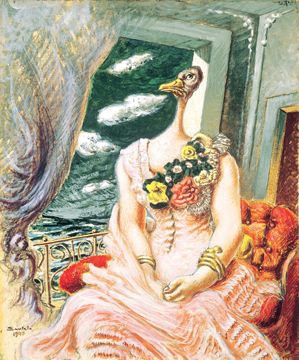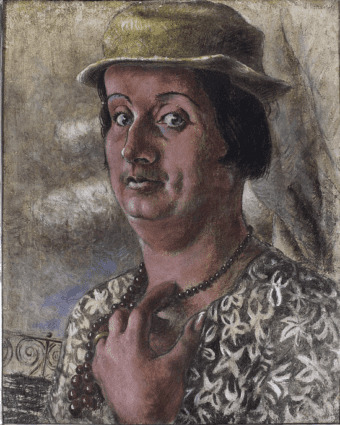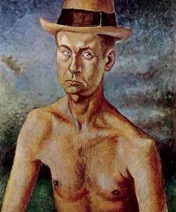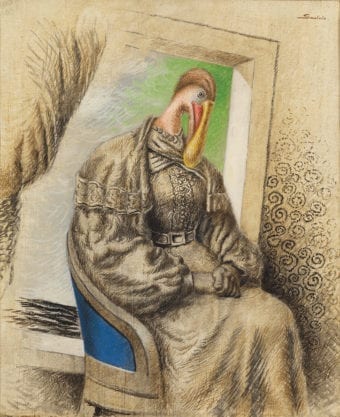De-heroizing Myths: Some Insights into “Capitano Ulisse”
Serena Alessi Serena Alessi Alberto Savinio, Issue 2, July 2019https://italianmodernart-new.kudos.nyc/journal/issues/alberto-savinio/
This article offers insight into Alberto Savinio’s play Capitano Ulisse (Captain Ulysses, 1934), with a particular focus on its representation of Penelope. An analysis of the play, in combination with an examination of some of Savinio’s paintings, illustrates how his peculiar rewritings of Homer’s Odyssey subvert mythology in order to mock bourgeois society. This article tries to shed light on the sense and scope of Savinio’s de-heroization of myths, namely his reshaping of these stories into new, ironic, and unheroic forms and meanings.
As with the whole of his oeuvre, the theater of Alberto Savinio is imbued with myth and Greekness. In particular, some of his most significant plays are inspired by Greek mythology’s female characters: Niobe, the protagonist of La morte di Niobe (The death of Niobe, 1925), a miming tragedy in music; Alcestis, the protagonist of Alcesti di Samuele (Alcestis, daughter of Samuel, 1949); and Jocasta, the model behind the protagonist of the monologue Emma B. Vedova Giocasta (Emma B. Widow Jocasta, 1949). 1 Despite not being the central character of a Savinio text, another remarkable figure to include in this list is Penelope, the wife of the Greek hero Ulysses, protagonist of the Odyssey; she appears in Capitano Ulisse (Captain Ulysses), a play written in 1925 and published in 1934. Being an expert on the poet, Savinio extensively represented Homer’s characters in his paintings as well as his writings, and the case of Penelope deserves special attention.
In Homer’s account, Ulysses, the king of Ithaca, undergoes a twenty-year-long exile: for a decade he is involved in the Trojan War, and for ten more years he is forced to wander at sea. During this long absence, the palace at Ithaca is occupied by suitors to Penelope, young local aristocrats, who attempt to court her and take possession of Ulysses’s holdings. Penelope, unaware of her husband’s destiny, invents a trick to delay responding to the suitors’ marriage requests: she says that she will wed one of them as soon as she finishes weaving a shroud for her father-in-law, Laertes. But each night she unravels what she has woven during the day, thus postponing the completion of her task. After four years the suitors discover the ruse, but luckily Ulysses comes back home in time to defeat them all and claim his kingdom. Reconquering his wife is a harder task, as Penelope does not immediately recognize her husband, who is disguised as a beggar. She thus tests Ulysses’s renowned cunning, asking a servant to move her bed out of her room. Only after proof of his identity – when Ulysses says that it is impossible to move the bed because it was carved from a tree with roots at the foundation of the palace – is Penelope ready to accept the man before her as her long-awaited husband.
Savinio delivers his own version of the myth of Penelope and Ulysses in Capitano Ulisse, created for Luigi Pirandello’s Teatro d’Arte, but staged by Nando Tamberlani in 1938 at the Teatro delle Arti in Rome. The play begins on Circe’s island: Ulysses, as captain of the last ship to survive the Trojan War, tells his sailors that the time has come to return home. The story continues on Calypso’s island and in the kingdom of the Phaeacians. The first two acts present similar situations: Ulysses has wandered for ten years since the war, and neither Circe nor Calypso can prevent him from being homesick. The gods and his sailors are all ready to plan another adventure for Ulysses, another departure, but he can no longer endure glory and endless success. The third act is set in Ithaca and begins immediately after the slaughter of the suitors and the recognition of Ulysses by Telemachus, his son. Penelope appears onstage as a bourgeois and small-minded housewife: Ulysses does not recognize his clever wife in this boring middle-aged lady, and decides to leave. This time, however, he does not have another journey in mind; misunderstood by everyone, he decides to leave the stage and the performance of his myth with one of the spectators, an integral group in the play.
In “La verità sull’ultimo viaggio” (The truth about his last journey), an essay published in the periodical Scena in 1976 and later included as the introduction to Capitano Ulisse, Savinio claims that he is the first and only person, after forty centuries of incomprehension, to understand Ulysses for what he really is: an unhappy man, eager to renounce his adventures for a bit of peace.
Nobody before me had discovered the weak point of Ulysses, his secret shame. It is true that neither he nor I are willing to consider it as such. I am the only one who could understand Ulysses, who would be able to take his stride. […] It was for some time that I suspected that the desire to “end it” was consuming Ulysses’s soul […]. Ulysses did not want to go onboard anymore, because he knew that as soon as he would start, the last trip would become the next-to-last. 2
Savinio gives Ulysses something that no other author had ever assigned to him: the possibility of becoming a normal man, a “nobody,” and dying. Moreover, Savinio expounds his reflections on heroes, observing that Ulysses cannot be considered as such because of his intelligence, which condemns him to be misunderstood. To understand Ulysses fully, to use his mythical function correctly, it is necessary to de-heroize him, the result of this operation being a parodic bourgeoisification of the character.
Every element of the script and scenes of Capitano Ulisse recalls bourgeois theater: middle-class settings and costumes; familiar, informal dialogues. However, despite all these domestic components, a number of factors indicate that Capitano Ulisse is not a piece of bourgeois theater; rather, Savinio uses the features of this genre to operate his subversion and to mock bourgeois society. Firstly, despite every social abasement, the names of Savinio’s characters remain identical to those of the classical text, indicating that the archetypes are still there and only the context in which they are to be interpreted has changed. The application of mythical characters’ names is not merely quotation in Savinio, it is a reminder that their meanings have not died. Secondly, and more importantly, the de-heroization itself acquires new meaning, considering the moment in which Capitano Ulisse was written – the middle of the fascist period in Italy. While the regime was using myth to build up a national discourse of power, Savinio de-heroized a mythical figure at the foundation of Western civilization by representing him as someone who no longer wants to be considered a hero and die as such.
This iconoclastic operation performed by Savinio prevents any ideological adaptation of the myth: the effect of this operation is extremely ironic, and irony, as part of the process of de-heroization, is Savinio’s personal way of fighting narrow-mindedness and coercion. 3 Homer is used by Savinio to deliver his personal assessment of contemporary bourgeois society: instead of mocking it, Savinio de-heroizes the myth and uses irony against all those whose uncompromising ways of thinking make it impossible to understand that modernity is no time for heroes.
Savinio’s modern and ironic Ulysses is surrounded by female figures: Circe, a passionate example of “D’Annunzian” love; Calypso, a motherly lover; Minerva, Ulysses’s rational guide who sometimes acts as a mentor but who ultimately, like all the others, pushes him towards another journey. 4 And finally there is Penelope, deprived of every element of originality. In Savinio’s treatment, Penelope has become completely two-dimensional: she is represented as a prosaic figure who pushes Ulysses away forever. While Ulysses understands now that heroes and poets no longer have haloes, Penelope does not likewise keep abreast of the times. Her story is stripped of royal dignity and only fit to be inserted into an informal chat between spectators.
SPECTATOR Such a nice lady! … Poor thing! … I feel sorry for her! … A woman, in the end, loses her husband, well! So be it! She knows, she will get over it, she maybe tries to find comfort, invent a new life … But in the dark! In the dark! … Ten years, just think of that! … Not to know if she is a widow, if her husband still lives? … Believe me, this is a tragic situation … 5
In Capitano Ulisse, before Penelope appears on the scene, the “Voce di Penelope” is already featured as a character in the script. At first Ulysses hears this voice offstage, but when Penelope emerges in the third act he neither recognizes her voice nor her person. Penelope seems the quintessence of the stingy and petty Italian housewife. Any chance of detecting a sign of feminine self-awareness or satisfaction in running her household independently is thwarted by her apparent ignorance and blindness. Savinio’s Penelope does not set a trap for Ulysses, she recognizes him as soon as he mentions the bed. She leaps dramatically towards him, making the third act of Capitano Ulisse a parody of the recognition scene in the Odyssey.
PENELOPE (While Ulysses was speaking she started to look at him with growing attention, then to tremble more and more violently, then to stare at him with hungry eyes, finally she screams.) Ulysses! Then it’s true! It’s you! … You’re back!!! (She throws herself with her arms open toward Ulysses.) Oh my spouse!6
Ulysses is disappointed by this woman who should have cherished the memory of their love in something deeper and stronger than a piece of furniture.
ULYSSES Penelope … she … would have recognized me because of mysterious signs, for subtle clues … the eyes … […] Instead … the memories … the domestic life … the marital bed … (Screaming all of a sudden with anger and contempt) Oh misery!7
Penelope’s recognition of Ulysses through a bed rather than through deeper, more intimate signs is taken as proof that the woman facing him is unable to see him as he really is. This time it is Ulysses who does not recognize Penelope, and, on the last page of the play, Penelope’s voice becomes a desperate scream that receives no answer.
SPECTATOR They are calling you, captain.
PENELOPE (In a desperate voice) Ulysses!
ULYSSES Strange. I haven’t heard a thing.8
Like Calypso, who desperately calls Ulysses to keep him with her, and remains unheard, Penelope is just another female voice for Savinio’s antihero. Ulysses is surrounded by women who represent the same thing for him: the impossibility of being understood, an obstacle to his wish to become a normal, mortal man. It is no surprise, then, that the characters of Circe, Calypso, and Penelope are all performed by the same actress, who thus represents a unique figure, a small-minded feminine essence demanding a hero who no longer exists.9
From the above observations it would be easy to conclude that Penelope is a negative figure for Savinio. Unable to achieve any intellectual height or depth, she is deprived of her voice and reduced to a mere object onstage. But her flattening is part of a broader process of de-heroization that is essential to Penelope’s self-liberation from her traditional representation as a merely chaste and loyal wife, and to her reshaping into a modern symbolic one.10 Moreover, a more complex and interesting interpretation of Capitano Ulisse and the flattening of Penelope is possible through the wider context of Savinio’s entire artistic production. In particular, it is in the light of his paintings that the figure of Penelope may be otherwise interpreted.
The catalogue raisonné of Savinio’s visual works records that he produced six paintings and three sketches entitled Penelope between 1930 and 1945.11 To these it is possible to add a number of works that, albeit under different titles, clearly reproduce the same subject: the paintings Le départ d’Ulysse (The departure of Ulysses, 1930); La fidèle épouse (The faithful wife, 1930–31); La vedova (The widow, 1931); and La fidanzata abbandonata (The abandoned girlfriend, 1931); and two sketches, Penelope e Ulisse (1945) and an untitled work (1949).12
In his personal mythology, Savinio interprets Penelope in different ways: in most of his paintings she is presented as a waiting figure with the head of an ostrich or a pelican (figure 1).

This choice offers two important interpretations. On the one hand, it is true that Savinio uses the head of a bird to represent many women, and especially to represent maternal figures (a chief example is a 1932 painting of Niobe). Consequently, the series of portraits of Penelope confirms his tendency to mix human and animal traits as peculiar to his artistic production. On the other hand, this choice is specific in its reference to the myth of Penelope, since one of the possible meanings of her name is “duck” (she was saved by ducks when her father attempted to kill her).

In a 1933 portrait, however, Penelope is not represented with any animal features (figure 2). A twin to this picture is a painting by Savinio of Ulysses, Il ritorno di Ulisse (The return of Ulysses), also from 1933 (figure 3).

The models for these two works were, respectively, his sister-in-law and her husband, who are both portrayed with bourgeois accessories (hats, a pearl necklace). There is a clear difference between these works and the hybrid Penelope presented in the other paintings, for in these two portraits, the subversion accomplished by the artist is similar to that of Capitano Ulisse. The myth is de-heroized by these pictorial representations. Though the subjects’ epic names are maintained in the title of each picture, the modern setting that surrounds said figures completely deprives them of their grandeur.13 In other portraits of Penelope, Savinio’s playful tampering with classical elements is even more obvious: her animalization witnesses her metamorphosis and her adaptation. The same half-bird, half-woman figure is presented in an attitude of expectation in paintings whose titles clearly reflect other elements of Penelope’s condition in the Odyssey: La fidèlè épouse, La fidanzata abbandonata, and La vedova (figure 4), and Le retour d’Ulysse.

Taking into account both Savinio’s Capitano Ulisse and his portraits of Penelope, further considerations emerge regarding his use of myth. Penelope has two different functions in Savinio’s production. The first is the one she has in Capitano Ulisse, where she is the negative counterpart of Ulysses and used by the playwright to carry out his own de-heroization of the myth. The second involves the canvases in which she is represented with a bird’s head, where she is also an active part of the subversion. In these paintings, the peculiar representation of Penelope clearly signals a clash between ancient and modern and, likewise, between nature (represented by Penelope’s head which refers to the animal origin of her myth) and culture (which manifests in the bourgeois setting, as well as Penelope’s dresses and pose). This point is comprehensible if one bears in mind the close relation that exists among Savinio’s various works: the models in his paintings may be seen as theatrical characters, with his Penelopes performing the new masques of his metaphysical theater, while the great importance given to captions, scenic designs (sketched by Savinio himself), and drawings (by his brother Giorgio de Chirico) inserted throughout the text demonstrate that Savinio’s theater is extremely visual.14
His surrealism goes beyond the naturalism of realistic painting, exactly as Capitano Ulisse goes beyond the naturalism of bourgeois theater. Interestingly, Savinio’s metaphysical theater and painting, though symbolic, also focus on the body, as is evident in the attention the artist dedicated to painting Penelope’s body. André Breton already grasped this when he inserted Savinio in his Anthologie de l’humour noir (Anthology of black humor, 1940), where he wrote of his language as “symbolic” and “concrete” at the same time.15 Savinio himself replied to the French writer in the preface to Tutta la vita (A whole life, 1945), providing an explanation of his personal surrealism:
Surrealism, like many of my writings and paintings can attest, is not happy with just representing what is shapeless and expressing what is unconscious, but it wants to give shape to what is shapeless and give consciousness to what is unconscious.16
Savinio’s desire to give shape (and names) to things is apparent in the figure of Penelope too. In Capitano Ulisse, Penelope, considered the “most domestic of women,” is associated and even equated with a urinal, the most domestic of all furnishings:
To give a nickname to Penelope, Ulysses had struggled much less […]. Penelope is the synonym of urinal. Eloquent euphemism. Metaphorically rich with meaning. The same word associates the most domestic of objects with the most domestic of women. Be it clear now and forever that each time Ulysses pronounces the name of his own wife, at the same time he expresses the idea of the urinal.17
Being named shapes the destiny of things and people: Penelope’s nickname designates her being. Names and naming are central points of Savinio’s oeuvre, as is evidenced by his creation of a personal dictionary, his Nuova enciclopedia (New encyclopedia, 1977). Myths and words are therefore in a synonymic relationship, and within his theater Savinio shows it not only in Capitano Ulisse but also in other plays, such as his later theatrical work Alcesti di Samuele, where he associates the words classico (classic) and gabinetto (toilet).18 Savinio’s originality lies in assigning to the ancient a word coming from an impoverished modern context: from this clash between ancient and modern something new emerges, something to rename, which is, ultimately, Savinio’s own code in his treatment of the figure of Penelope.
Bibliography
Alessi, Serena. “L’uguaglianza e la differenza: il tempo di Penelope.” In Femminismo e femminismi nella letteratura italiana dall’Ottocento al XXI secolo, edited by Sandra Parmegiani and Michela Prevedello, 227–43. Florence: Società Editrice Fiorentina, 2019.
Bramanti, Vanni. Gli dei e gli eroi di Savinio. Palermo: Sellerio, 1983.
Breton, André. Anthology of Black Humor. Translated by Mark Polizzotti. San Francisco: City Lights Books, 1997.
Gordon, Mel. “Alberto Savinio and the Teatro Metafisico.” Performing Arts Journal 9, no. 1 (1985): 83–88.
Gutiérrez, María Elena. Alberto Savinio. Lo psichismo delle forme. Florence: Cadmo, 2000.
Savinio, Alberto. Alcesti di Samuele e atti unici. Milan: Adelphi, 1991.
Savinio, Alberto. Nuova enciclopedia. Milan: Adelphi, 1991.
Savinio, Alberto. Tutta la vita. Milan: Bompiani, 1969.
Vivarelli, Pia. Alberto Savinio: catalogo generale. Milan: Electa 1996.
How to cite
Serena Alessi, “De-heroizing Myths: Some Insights into ‘Capitano Ulisse’,” in Alberto Savinio, monographic issue of Italian Modern Art, 2 (July 2019), https://www.italianmodernart.org/journal/articles/de-heroizing-myths-some-insights-into-capitano-ulisse/, accessed [insert date].
- The figures of Niobe, Alcestis, Jocasta, and Penelope in Alberto Savinio’s theater are the subject of a longer publication I am currently preparing. I thank CIMA for granting me the opportunity to present some parts of the forthcoming article.
- “Nessuno prima di me aveva scoperto il punto debole di Ulisse, la sua segreta vergogna. Vero è che nè lui nè io siamo disposti a considerarla tale. Sono il solo che possa capire Ulisse, che lo sappia pigliare per il suo verso. […] Che una grandissima voglia di ‘finirla’ struggesse l’animo di Ulisse, era un bel po’ che lo sospettavo […]. Ulisse non voleva imbarcarsi più, perché sapeva che appena iniziato, l’ultimo viaggio si converte in penultimo.” Alberto Savinio, Capitano Ulisse (Milan: Adelphi 2003), 14–21. All translations in this essay are mine.
- See María Elena Gutiérrez, Alberto Savinio. Lo psichismo delle forme (Florence: Cadmo, 2000), 134.
- See Vanni Bramanti, Gli dei e gli eroi di Savinio (Palermo: Sellerio, 1983), 50–54.
- “Una così brava signora! … Poverina! … Fa pena! … Una donna, in fine, perde il marito, beh! pazienza! lo sa, si fa una ragione, cerca magari di consolarsi, crearsi una nuova vita … Ma al buio! al buio! … Dieci anni, pensi! … Non sapere se è vedova, se il marito vive ancora? … Creda, è una situazione tragica.” Savinio, Capitano Ulisse, 65.
- “(Mentre Ulisse parlava ha cominciato a guardarlo con attenzione crescente, poi a tremare con violenza sempre maggiore, poi a fissarlo con occhi divoranti, in ultimo lancia un grido). Ulisse! È vero dunque! Sei tu! … Sei tornato!!! (Si slancia, le braccia aperte, verso Ulisse) O mio sposo!” Ibid., 120.
- “Penelope … lei … mi avrebbe riconosciuto per segni misteriosi, per indizi sottilissimi … gli occhi … […] Invece … i ricordi … la vita domestica … il letto coniugale … (prorompendo improvvisamente, con ira e disprezzo) O miseria!” Ibid., 123.
- “SPETTATORE: Chiamano lei, capitano. PENELOPE: (con voce disperata) Ulisse! ULISSE: Strano. Non ho sentito nulla.” Ibid., 131.
- This is made clear by the list of characters at the beginning of the play and from a letter written by Savinio to the theater director Guido Salvini on November 18, 1925. See ibid., 32, 144.
- For a more complete overview of the traditional representation of Penelope, see my “L’uguaglianza e la differenza: il tempo di Penelope,” in Femminismo e femminismi nella letteratura italiana dall’Ottocento al XXI secolo, ed. Sandra Parmegiani and Michela Prevedello (Florence: Società Editrice Fiorentina, 2019), 227–43, 227–30.
- See Pia Vivarelli, Alberto Savinio: catalogo generale (Milan: Electa, 1996), 111, 148, 151, 168, 174, 249, 250, 283.
- Ibid., 109, 111, 117, 118, 329, 354.
- See Pia Vivarelli’s commentary on the painting Il ritorno di Ulisse (1933): “Il gioco di Savinio è quindi doppio: mitizza il quotidiano attraverso i titoli e le pose e, nello stesso tempo, presenta una gamma varia e contrastante di aspetti del mito, […] ora banalizzato dalla contemporaneità, ora deformato dalle similitudini con il mondo animale.” Ibid., 148.
- See Gutiérrez, Alberto Savinio, 92. See also Mel Gordon, “Alberto Savinio and the Teatro Metafisico,” Performing Arts Journal 9, no. 1 (1985): 83–88.
- See André Breton, Anthology of Black Humor, trans. Mark Polizzotti (San Francisco: City Lights Books, 1997), 287.
- “Il surrealismo, come molti miei scritti e molte mie pitture stanno a testimoniare, non si contenta di rappresentare l’informe e di esprimere l’incosciente, ma vuole dare forma all’informe e coscienza all’incosciente.” Alberto Savinio, Tutta la vita (Milan: Bompiani, 1969), 7–8.
- “Per dare un soprannome a Penelope, Ulisse ha faticato molto meno […]. Penelope è sinonimo di orinale. Eufemismo eloquente. Traslato ricco di significati. La stessa parola associa la più domestica delle suppellettili alla più domestica delle donne. Sia inteso ora e per sempre che ogni qualvolta Ulisse pronuncia il nome della propria moglie, egli esprime contemporaneamente l’idea di orinale.” Savinio, Capitano Ulisse, 25–26.
- See Alberto Savinio, Alcesti di Samuele e atti unici (Milan: Adelphi, 1991), 65–66.

